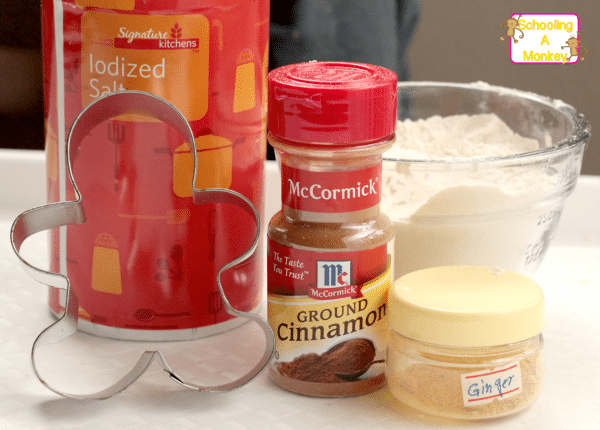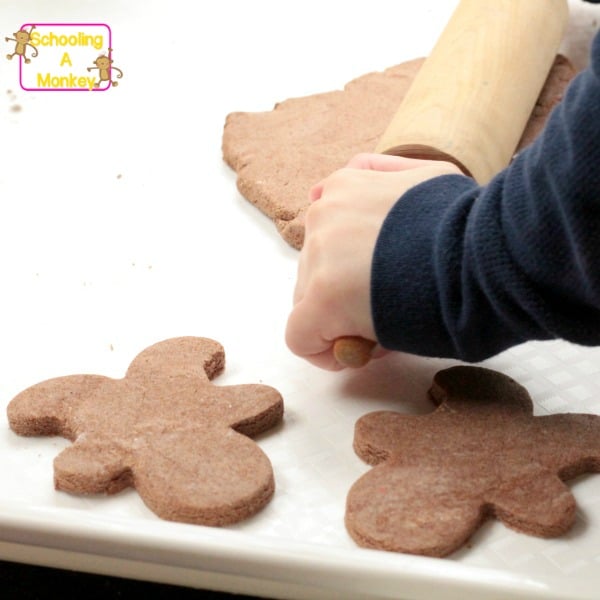When it comes to gingerbread ornaments, nothing is more fun than making your own. These gingerbread ornaments are a fun science experiment for kids and fit right in with Christmas tree STEM activities! Try out this gingerbread ornament recipe for long-lasting gingerbread ornaments that smell delicious and add a bit of STEM flair to your holiday season!

We love gingerbread at our house, and one of my fondest memories as a child was making cinnamon dough ornaments with my mom. We hung those ornaments on our tree year after year, even though one was literally in the shape of a rock (my mom had long since given up on class as a mother of 6).
Of course, we couldn’t help but realize that any sort of cooking is an exercise in science and makes the perfect Christmas science experiment!
When cooking these ornaments, we learned a lot about how to preserve things, how to mix ingredients to create a stable dough, oven cook times, measuring, and a whole lot more. Therefore, I declare this gingerbread ornament recipe a holiday STEM activity.
Table of Contents
The Science of Gingerbread
Ever wonder the science behind gingerbread? What makes a gingerbread recipe last longer than other gingerbread recipes?
Learn the answers to these questions and more, plus get a super easy gingerbread ornament recipe that you can use to make long-lasting gingerbread ornaments for the holiday season all while learning about the science of baking gingerbread!
Gingerbread Science Facts
Here are some science principles to discuss while making gingerbread ornaments with your students.
Leavening agents such as baking soda and baking powder create gas bubbles (carbon dioxide) when mixed with moisture and heat. The gas expands during baking, making the gingerbread cookies rise and become fluffy.
Fat used in gingerbread recipes coats the flour particles, which reduces gluten formation. Gluten is a protein that can make cookies tough if overdeveloped.
Sugar sweetens the cookies, but it also affects texture. It attracts water, which helps keep cookies moist and soft. Sugar can also make cookies tender by inhibiting gluten formation.
Eggs act as binders and provide structure. Egg proteins coagulate during baking, helping to hold the cookies together.
While baking, gingerbread cookies go through a process known as the “Maillard reaction.” The Maillard reaction is a chemical reaction that occurs between amino acids and reducing sugars when exposed to heat.
This reaction is responsible for the browning, flavor, and aroma changes that occur in a variety of foods when they are cooked, roasted, toasted, or otherwise exposed to high temperatures.
How long do gingerbread ornaments last?
Edible gingerbread ornaments only last one holiday season, but if you follow the recipe below, your gingerbread ornaments will last for years!
Add a clear sealer over your acrylic paint the answer to the question how long do homemade gingerbread ornaments last could be decades!
Gingerbread Ornaments How To
We did a variation between the classic cinnamon ornaments and salt dough gingerbread ornaments to make our gingerbread science Christmas ornaments.

This is what you’ll need:
- 1/2 cup of salt
- 1 cup of flour
- 3/4 cup molasses
- 1/4 cup cinnamon
- 1 tablespoon ginger
- 1 tablespoon pumpkin pie spice
- Acrylic paints
- Paintbrushes
- Plastic straws
- Gingerbread cookie cutter
- String
- Rolling pin
- Cookie sheet
- Timer
- Cooling rack
- Parchment paper
- Clear sealer
- Mixing bowls
- Hand mixer
Hands-On STEM Resources about Trees
Here are some hands-on STEM resources about trees that can be used alongside this Christmas tree STEM activity.
Step by Step Directions to Make Gingerbread Man Ornaments
Here is how to make gingerbread cookie ornaments using my favorite cinnamon-based recipe.
Mix the dry ingredients first. If your dough isn’t sufficiently dark, you can add more cinnamon.
Add the water a little at a time. You want the dough to look and feel like real gingerbread dough.
However, the salt content will make it a little grainier.
Heat the oven to 250 degrees Fahrenheit.

While the oven is heating, roll out your dough to about 1/4 of an inch thick. Cut out your gingerbread people and place them on a cookie sheet. I think our recipe made 7.
Use a straw to make a hole in the top of each gingerbread person.
Cook your gingerbread people about 1 hour per side. We cooked ours until they looked dry on both sides.
We made our dough a little thicker than we should have, so some of our gingerbread men took about three hours to bake properly.
Let the salt dough gingerbread ornaments cool completely.

What paint to use on gingerbread ornaments?
When the gingerbread man Christmas ornaments are cool, you can paint them with any fast-drying paint. We found that acrylic paint was the easiest to work with without over-saturating the dough.
How do you seal gingerbread ornaments?
We sealed our ornaments with a clear acrylic sealer. However, if you seal the entire surface or it won’t smell like gingerbread, but they will last years longer.
Tie a string through the hole, and your long lasting gingerbread ornaments are ready to go!
Books about Christmas Trees
These science books about evergreen trees will be a good addition to any Christmas tree STEM project!
Molded Salt Dough Gingerbread STEM Extensions
Here are a few ways you can expand on this gingerbread ornament recipe and add more STEM activities to your festive fun.
Experiment with different quantities of leavening agents to determine the optimal amount for gingerbread cookies.

Investigate the impact of additional variables, such as the type of fat used (e.g., butter vs. shortening), on cookie texture and taste.
Try cooking the gingerbread at various temperatures and for varying times to see how that affects the cookie taste, structure, and lifespan.
Gingerbread Science Lesson Plan
Here is a printable lesson plan you can use to go along with the gingerbread ornament recipe to turn the cooking activity into a STEM activity!
Gingerbread Science Christmas Ornaments Lesson Plan
Instructions
Learning Objectives:
- Understand the chemical reactions involved in making gingerbread dough.
- Determine how different preservation methods will make the gingerbread ornaments last longer.
- Discuss how changing variables in ingredients or the cooking process will change the texture and strength of the gingerbread ornaments.
Introduction (15 minutes):
Begin with a brief discussion about gingerbread and its historical and cultural significance. Mention its use in various holiday traditions.
Share the learning objectives with students and explain that they will be making gingerbread ornaments while exploring the chemistry involved.
Chemistry of Gingerbread (10 minutes):
Present a brief overview of the chemistry involved in gingerbread.
Discuss key ingredients and their roles, such as:
- Flour (structure)
- Baking soda (leavening agent)
- Molasses (flavor and color)
- Sugar (sweetness)
- Butter (fat for texture)
- Spices (flavor)
Preparation (15 minutes)
Have the students make several batches of dough with different recipe variations.
Preheat the oven to 250 degrees for the classic recipe.
Demonstrate how to roll out the dough to approximately 1/4-inch thickness using rolling pins.
Cut out the gingerbread ornaments with a gingerbread man cookie cutter or other festive cookie cutters.
Use a drinking straw to create a hole near the top of each ornament for hanging.
Place the ornaments on baking sheets lined with parchment paper.
Bake the ornaments in the preheated oven for about 2 hours.
Allow the ornaments to cool completely before decorating.
Decorating Gingerbread Ornaments (20 minutes)
Provide students with the materials to paint their ornaments with acrylic paint. Leave some unpainted, and seal some of the painted ornaments to see which ornament lasts longest.
Observation:
Have the students observe the ornaments right out of the oven, and then over a period of several weeks.
Have them record the differences in recipe and preservation methods in their STEM journals.
Discussion:
Discuss how the different variations in baking time, ingredients, and preservation methods changed the strength, texture, and lifespan of the gingerbread ornaments.
Have the students pick a favorite recipe.
Assessment:
Assess students based on their understanding of the lesson objectives and contributions to class discussions.
Recommended Products
As an Amazon Associate and member of other affiliate programs, I earn from qualifying purchases.
Teacher Christmas Tree Shirts
Here are some adorable Christmas tree shirts for teachers!
Chemist Tree Christmas Tree Teacher Shirt
Evergreen Christmas Tree Teacher Shirt
Math Christmas Tree Teacher Shirt
Books Christmas Tree Teacher Shirt
Pencil Christmas Tree Teacher Shirt

Forest Christmas Tree Teacher Shirt
Music Box Christmas Tree Teacher Shirt











